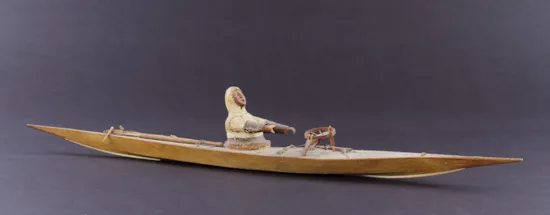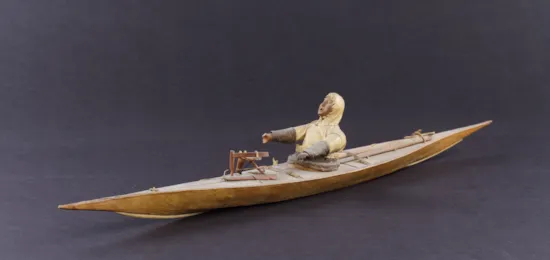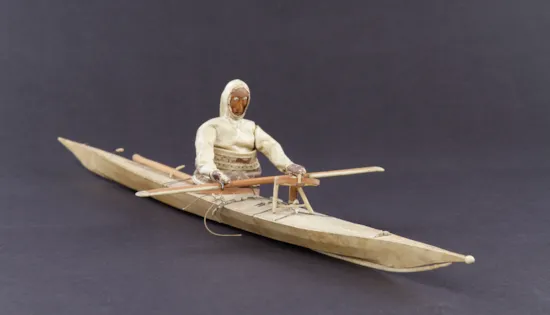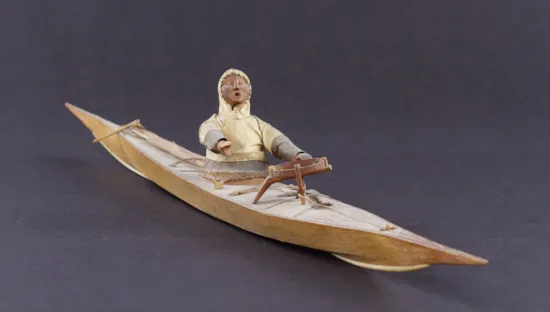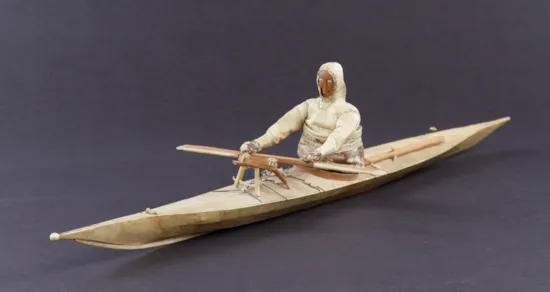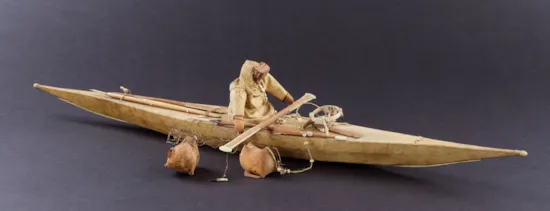A Collection of Three Greenlandic Arctic Eskimo Inuit Kayak Models each Complete with Their Hunting Figures and Equipment
A Collection of Three Greenlandic Arctic Eskimo Inuit Kayak Models each Complete with Their Hunting Figures and Equipment
One figure wearing goggles two with inlaid eyes
All three with harpoons float boards paddles harpoon rests and two with flotation seal bladders
Late 19th – Early 20th Century
Sizes:
a: 55cm long - 21½ ins long
b: 64cm long - 25¼ ins long
c: 65cm long - 25½ ins long
One figure wearing goggles two with inlaid eyes
All three with harpoons float boards paddles harpoon rests and two with flotation seal bladders
Late 19th – Early 20th Century
Sizes:
a: 55cm long - 21½ ins long
b: 64cm long - 25¼ ins long
c: 65cm long - 25½ ins long
A Collection of Three Greenlandic Arctic Eskimo Inuit Kayak Models each Complete with Their Hunting Figures and Equipment
One figure wearing goggles two with inlaid eyes
All three with harpoons float boards paddles harpoon rests and two with flotation seal bladders
Late 19th – Early 20th Century
Sizes:
a: 55cm long - 21½ ins long
b: 64cm long - 25¼ ins long
c: 65cm long - 25½ ins long
One figure wearing goggles two with inlaid eyes
All three with harpoons float boards paddles harpoon rests and two with flotation seal bladders
Late 19th – Early 20th Century
Sizes:
a: 55cm long - 21½ ins long
b: 64cm long - 25¼ ins long
c: 65cm long - 25½ ins long
An entry in Lieutenant Commander Riley’s diary for March 31st 1933 states ‘Kidaze brought me my model kayak in return for a vest of Gino’s and a pair of Q R’s (old) trousers’. Riley was a member of the British Arctic Air Route Expedition of 1930 - 31 for which he received the Polar Medal. He returned to Greenland in 1932 to undertake further meteorological and general studies of flying conditions.
These three carefully made models skilfully portray the vessel and the hunting paraphernalia of Greenlandic Inuit. A hunter’s kayak is his most prized possession and symbol of manhood. Great attention is paid to the craftsmanship used in manufacturing the vessel, but it is not ready to go to sea until it has been given personal and shamanic marks and symbols. Inside the boat the hunter places amulets which are known only to him, and lashed to the cockpit are charms in the form of smiling male and female faces to protect him from the powerful and sometimes evil spirits that dwell in the sea.
Kayaks are made in a number of regional styles, but in many cases this variation is meant only to reinforce the identity of local groups while also serving to make the hunters identity known at a safe distance. The origin of the kayak is not known, but it was probably developed when the peoples of the Arctic learnt to hunt large sea mammals in the icy waters more than ten thousand years ago. Its driftwood frame enclosed in a tight skin covering makes it strong and flexible and enables it to be hauled up on land or ice by a single hunter. It will not freeze or be cut by newly formed ice and when handled by an experienced paddler equipped with a spray skirt tied around the cockpit it is virtually unsinkable.
These three carefully made models skilfully portray the vessel and the hunting paraphernalia of Greenlandic Inuit. A hunter’s kayak is his most prized possession and symbol of manhood. Great attention is paid to the craftsmanship used in manufacturing the vessel, but it is not ready to go to sea until it has been given personal and shamanic marks and symbols. Inside the boat the hunter places amulets which are known only to him, and lashed to the cockpit are charms in the form of smiling male and female faces to protect him from the powerful and sometimes evil spirits that dwell in the sea.
Kayaks are made in a number of regional styles, but in many cases this variation is meant only to reinforce the identity of local groups while also serving to make the hunters identity known at a safe distance. The origin of the kayak is not known, but it was probably developed when the peoples of the Arctic learnt to hunt large sea mammals in the icy waters more than ten thousand years ago. Its driftwood frame enclosed in a tight skin covering makes it strong and flexible and enables it to be hauled up on land or ice by a single hunter. It will not freeze or be cut by newly formed ice and when handled by an experienced paddler equipped with a spray skirt tied around the cockpit it is virtually unsinkable.
Ex Private collection of the Late Polar Explorer Lieutenant Commander Quintin Riley (1905 - 1980)
Thence by descent
Thence by descent
A Collection of Three Greenlandic Arctic Eskimo Inuit Kayak Models each Complete with Their Hunting Figures and Equipment

SOLD
